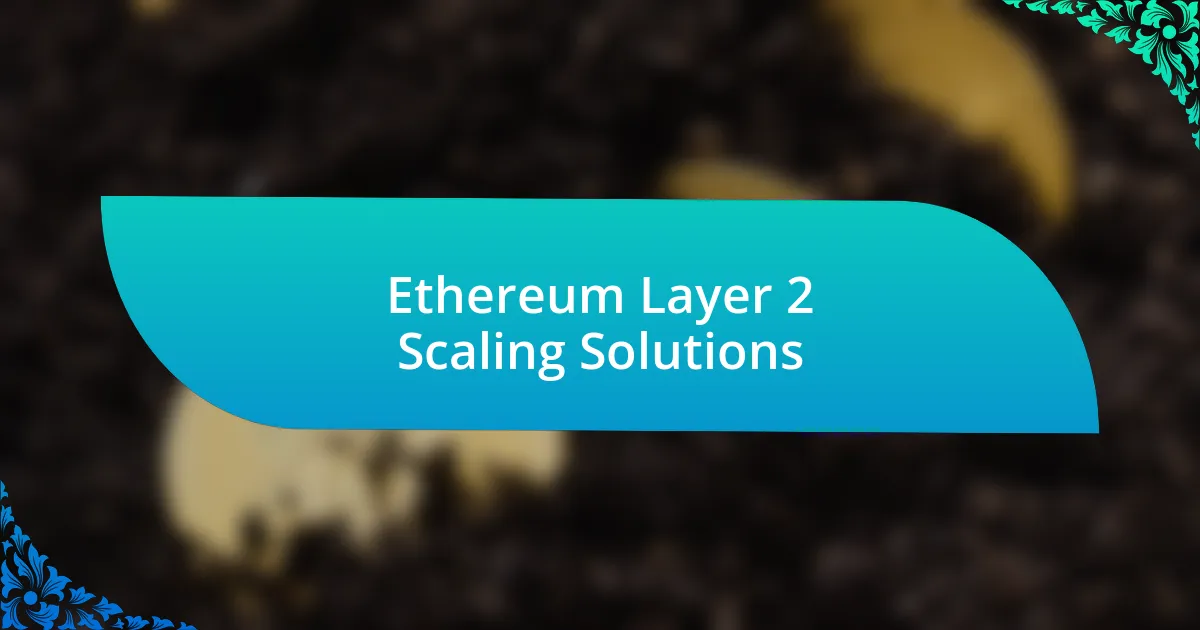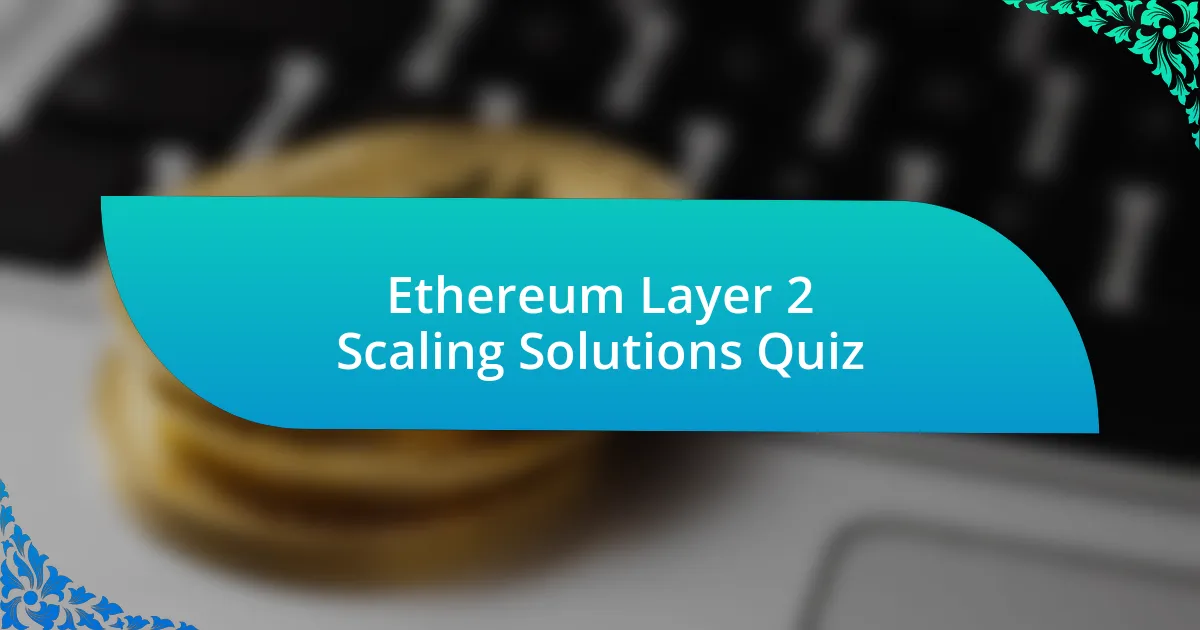
Start of Ethereum Layer 2 Scaling Solutions Quiz
1. What are Layer 2 solutions primarily designed to do in the Ethereum ecosystem?
- Layer 2 solutions create new Ethereum tokens.
- Layer 2 solutions handle transactions off-chain to increase speed and reduce fees.
- Layer 2 solutions increase block size on Ethereum.
- Layer 2 solutions are solely for storing data.
2. Which Ethereum scaling solution aims to enhance transaction speeds and reduce costs?
- IOTA
- Cosmos
- Helium
- Optimism
3. What technology is used by Optimism to optimize transaction handling?
- Transaction sharding
- Optimistic rollup technology
- Sidechain technology
- Proof of work mechanism
4. What popular decentralized application platform has integrated with Arbitrum?
- Solana
- Avalanche
- Optimism
- Binance Smart Chain
5. What is the current Total Value Locked (TVL) for the Layer 2 solution Optimism?
- $700 million
- $1.5 billion
- $3.2 billion
- $4.1 billion
6. Which company launched the Layer 2 solution named Base?
- Bitfinex
- Coinbase
- Binance
- Kraken
7. What is the main benefit of optimistic rollups compared to traditional Ethereum transactions?
- Enhanced cross-chain compatibility and higher costs.
- Increased latency and more complex transactions.
- Reduced transaction speeds and higher fees.
- High scalability and low gas fees.
8. How does the withdrawal process work on the Optimism Layer 2 solution?
- Withdrawals take up to one week to complete to ensure security.
- Withdrawals are calculated monthly based on transaction volume.
- Withdrawals can only be processed during specific times of the day.
- Withdrawals are instant and require no waiting period.
9. In Optimism, what role does the sequencer play in transaction processing?
- The sequencer conducts market analysis for price predictions.
- The sequencer is responsible for bundling transactions and ensuring their validity.
- The sequencer verifies transactions with user passwords.
- The sequencer generates new cryptocurrency coins.
10. What efficiency do optimistic rollups provide for Ethereum transactions?
- No scalability and no fees.
- Low scalability and high fees.
- Moderate scalability and variable fees.
- High scalability and low gas fees.
11. Which Layer 2 project is noted for its compatibility with projects like Uniswap and Synthetix?
- Base
- Arbitrum
- Optimism
- Polygon
12. How does Arbitrum enhance Ethereum`s smart contract functionality?
- Arbitrum only enhances Ethereum by reducing the block size on the mainnet.
- Arbitrum eliminates the need for smart contracts entirely on the Ethereum network.
- Arbitrum executes transactions off-chain before bundling them into large batches, which are submitted to the Ethereum mainnet as calldata.
- Arbitrum processes all transactions on-chain directly to Ethereum for maximum security.
13. What framework is suggested for evaluating Layer 2 scaling projects?
- Four questions to judge any Layer 2 scaling solution.
- Five factors to analyze Layer 2 systems.
- Two metrics for evaluating Layer 2 networks.
- Three criteria for assessing Layer 2 projects.
14. Why are data checkpoints critical for Layer 2 implementations?
- To reconcile data with the Ethereum mainnet.
- To prevent all types of data losses.
- To develop new cryptocurrencies independently.
- To increase transaction fees for users.
15. Which innovative technology does Polygon zkEVM utilize for transaction validation?
- smart contracts
- consensus algorithms
- zk-proofs
- hash functions
16. What method does Polygon zkEVM use to increase transaction throughput?
- zk-rollups
- Sharding
- Sidechains
- State channels
17. How does using Optimism affect the cost of transactions for Ethereum users?
- No change in transaction costs or speed.
- Cheaper transactions and an improved user experience.
- Higher transaction fees and slower speed.
- Increased complexity in using Ethereum.
18. What security measure does Optimism enforce for questionable transactions?
- A one-week window for validators to submit a fault proof.
- Random audits of transactions every month.
- Automatic approval of all transactions.
- Immediate rejection of suspicious transactions.
19. What feature makes Base attractive for developers transitioning from Ethereum?
- Developer-friendly environment
- Advanced security features
- Lower programming costs
- High transaction speed
20. What objective does Base focus on to encourage institutional relationships?
- Profit maximization and market dominance.
- Enhanced privacy and data protection.
- User base expansion and marketing strategy.
- Regulatory compliance and institutional adoption.
21. How does Optimism balance transaction costs with blockchain security?
- By requiring all transactions to be approved by users instantly.
- By assuming transactions are valid and allowing validation queries within a week.
- By executing transactions directly on the main blockchain without any verification.
- By using a centralized authority to control transaction confirmations.
22. What is sharding in relation to Ethereum scalability solutions?
- Sharding involves merging multiple blockchains into one.
- Sharding is the process of splitting the blockchain into smaller parts to enhance scalability.
- Sharding is a technique for encrypting transactions on the Ethereum network.
- Sharding refers to creating larger blocks to reduce transaction times.
23. How does Optimism compare in terms of effectiveness against other Layer 2 solutions?
- Inefficient and slow transaction processing.
- Only supports a few applications.
- High scalability and low gas fees.
- Limited functionality and high fees.
24. Describe the transaction batching method used by Optimism.
- Transactions are annotated and then packaged and sent in bulk to Layer 1.
- Transactions are submitted directly to Layer 2 without bundling.
- Transactions are separated and processed one at a time on Layer 1.
- Transactions are encrypted and individually sent to Mainnet.
25. What is the primary outcome of transaction bundling by Optimism`s sequencer?
- Slower processing times and verification.
- Reduced gas fees and instant confirmation on Layer 2.
- Increased latency and transaction costs.
- Enhanced security with longer confirmation periods.
26. What advantage does Optimism gain from its connection to Ethereum?
- Limited network access
- Guaranteed scalability
- Higher fees for users
- Increased transaction delays
27. Which solutions are classified as “optimistic rollups”?
- Polygon
- Base
- Avalanche
- Optimism
28. In what way does Optimism distribute gas fees among users?
- By sharing the cost of gas fees between users whose transactions are in the bundle.
- By randomly assigning gas fees to users without any criteria.
- By imposing a flat fee on every transaction regardless of bundling.
- By charging higher fees for larger transactions only.
29. What are the development advantages associated with utilizing Optimism?
- Slower transaction confirmation times.
- Cheaper transactions and an improved user experience.
- Increased transaction fees for users.
- More complex development tools for programmers.
30. Which Layer 2 solution has notably risen in prominence recently?
- Arbitrum
- Base
- Polygon
- Optimism

Congratulations! You’ve Successfully Completed the Quiz
Well done on finishing the quiz about Ethereum Layer 2 scalability solutions! You’ve explored the key concepts and strategies that can enhance the efficiency of transactions on the Ethereum network. This knowledge is crucial in understanding how these solutions can address the issues of speed and cost in blockchain technology.
Throughout this quiz, you likely gained insights into the different types of Layer 2 solutions, such as rollups and state channels. You may have also discovered how these solutions impact Ethereum’s overall scalability and usability. Each correct answer not only tested your knowledge but also reinforced the importance of these technologies in the evolving crypto space.
If you found this topic intriguing, we invite you to dive deeper into our next section on Ethereum Layer 2 scaling solutions. This resource provides more information and analysis, increasing your understanding and helping you stay informed about the latest developments in this area. Your journey into the world of blockchain continues here!

Ethereum Layer 2 Scaling Solutions
Understanding Ethereum Layer 2 Scaling Solutions
Ethereum Layer 2 scaling solutions refer to various technologies designed to enhance the scalability of the Ethereum network. They operate on top of the Ethereum blockchain, alleviating congestion and lowering transaction costs. The primary aim is to improve transaction throughput while maintaining the security and decentralization of the main chain. Solutions such as rollups, sidechains, and state channels exemplify these Layer 2 developments, allowing for faster transaction processing and improved user experience.
The Purpose and Benefits of Layer 2 Solutions
The main purpose of Ethereum Layer 2 solutions is to increase the network’s capacity to handle more transactions simultaneously. By offloading some of the transaction processing away from the main Ethereum chain, they reduce gas fees and improve transaction speeds. These benefits are particularly important during periods of high network demand, such as during Ethereum’s high-profile events or decentralized finance (DeFi) surges. Lower fees and faster confirmations help boost user engagement and adoption of Ethereum-based applications.
Types of Ethereum Layer 2 Solutions
There are several prominent types of Ethereum Layer 2 solutions, each with distinct methodologies. Rollups, including Optimistic and ZK-Rollups, aggregate multiple transactions into one, proving their validity off-chain. Sidechains operate independently but remain connected to the Ethereum network, allowing for custom features and reduced congestion. State channels enable instant transactions between parties off the main chain, further decreasing transaction load. Each type contributes uniquely to Ethereum’s scalability and effectiveness.
Current Popular Layer 2 Solutions on Ethereum
Several Layer 2 solutions have gained popularity in the Ethereum ecosystem. Polygon, previously known as Matic Network, combines various Layer 2 technologies to enhance transaction throughput. Arbitrum and Optimism focus on Optimistic Rollups, enabling faster transaction settlements. zkSync employs zero-knowledge proofs for ZK-Rollups, offering enhanced privacy and efficiency. These solutions have seen significant adoption and integration within DeFi and NFT platforms, demonstrating effective scalability.
Challenges and Future of Layer 2 Solutions
Despite their benefits, Ethereum Layer 2 solutions face challenges. Interoperability between different Layer 2 networks remains a significant hurdle, complicating cross-platform transactions. Security concerns also arise, especially with new technologies undergoing extensive testing. Looking forward, continued development is critical. Innovations in Layer 2 solutions, along with Ethereum upgrades like the transition to Ethereum 2.0, aim to further enhance scalability, security, and overall network efficiency.
What are Ethereum Layer 2 Scaling Solutions?
Ethereum Layer 2 Scaling Solutions are technologies designed to improve the transaction speed and reduce costs on the Ethereum network. They operate on top of the Ethereum main chain and help alleviate congestion by processing transactions off-chain. Prominent examples include Optimistic Rollups and zk-Rollups, which enhance scalability while maintaining security through the underlying Ethereum blockchain.
How do Ethereum Layer 2 Scaling Solutions work?
Ethereum Layer 2 Scaling Solutions work by bundling multiple transactions into a single batch, which is then submitted to the Ethereum main chain. This reduces the overall number of transactions that need to be processed on-chain, thereby increasing speed and lowering fees. For instance, Optimistic Rollups assume transactions are valid unless proven otherwise, minimizing the computational load on the Ethereum layer, while zk-Rollups use cryptographic proofs to validate batches of transactions efficiently.
Where can Ethereum Layer 2 Scaling Solutions be implemented?
Ethereum Layer 2 Scaling Solutions can be implemented across various decentralized applications (dApps) that operate on the Ethereum blockchain. They are particularly beneficial for applications requiring high throughput, such as decentralized exchanges and gaming platforms. Developers integrate these solutions into their projects to optimize performance and user experience by reducing latency and fees.
When were Ethereum Layer 2 Scaling Solutions introduced?
Ethereum Layer 2 Scaling Solutions began gaining traction in 2018, with significant developments occurring in the following years. The introduction of protocols like zk-SNARKs and advancements in Rollup technology marked a pivotal point. By 2020, various Layer 2 projects emerged, aiming to address Ethereum’s scalability challenges amid growing network congestion due to increased usage.
Who benefits from Ethereum Layer 2 Scaling Solutions?
Various stakeholders benefit from Ethereum Layer 2 Scaling Solutions, including developers, end-users, and businesses. Developers can create more responsive and cost-effective applications. End-users experience lower transaction fees and faster processing times. Businesses leveraging decentralized finance (DeFi) and NFTs gain an edge as they can operate more efficiently, attracting a larger user base. According to Ethereum’s recent metrics, adoption of Layer 2 solutions has significantly increased in response to these benefits.

